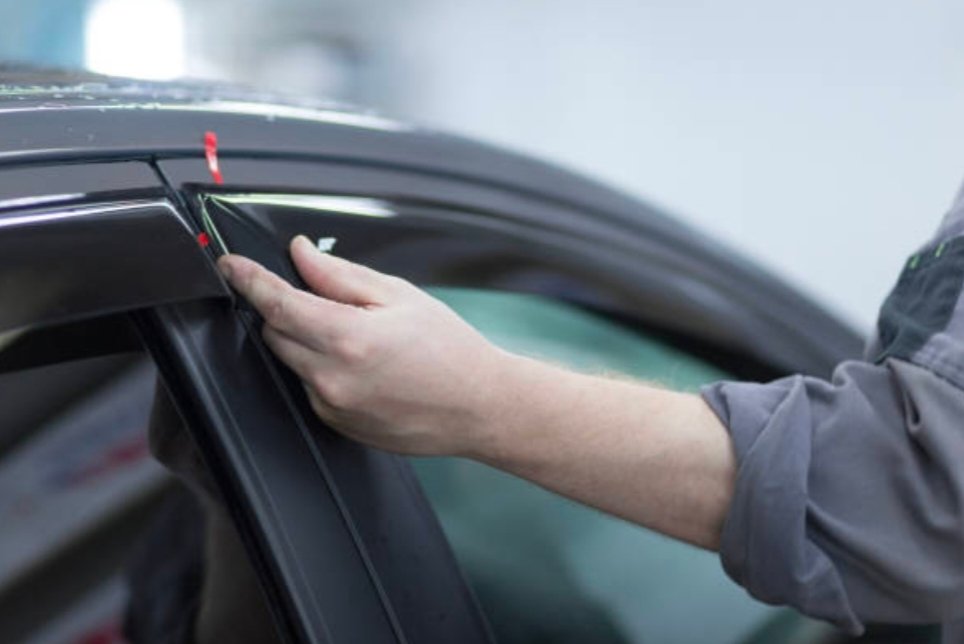Blog
The Ultimate Guide to Car Window Tinting

Car window tinting enhances privacy, reduces glare, and blocks UV rays, protecting interiors and passengers. Key considerations include selecting the right tint type, understanding local regulations, and professional installation. Quality tints improve aesthetics, increase comfort, and boost vehicle resale value, making it a worthwhile investment.
The Benefits of Car Window Tinting
Car window tinting offers numerous practical benefits beyond aesthetics. It provides:
- UV protection.
- Blocking up to 99% of harmful UV rays.
- Reducing interior fading and preventing premature cracking and warping of upholstery.
It also enhances privacy and security by making it harder for outsiders to see inside the vehicle, deterring potential break-ins. Additionally, tinted windows help maintain temperature control by reflecting sunlight, making driving more comfortable and reducing the need for air conditioning, thus improving fuel efficiency. Overall, car window tinting offers numerous advantages beyond aesthetics. Opting for professional window tinting services can provide peace of mind and quality assurance for those interested in long-lasting results.
Different Types of Window Tint Films
Window tint films come in various types: dyed, metalized, hybrid, carbon, and ceramic. The least expensive choice is dyed film, which could only last briefly or be as efficient against UV radiation. Metalized film reflects heat and UV rays but can interfere with electronic signals. Hybrid films combine dyed and metalized layers to balance performance and cost, offering significant heat and UV protection while reducing potential signal interference. Carbon tints do not fade and provide excellent UV protection and heat rejection without metal, preventing signal issues. Ceramic tints are top-of-the-line, providing superior heat and UV rejection without affecting electronic signals. Despite their higher cost, ceramic tints are known for their durability and effectiveness, making them a worthwhile investment.
Choosing the Right Tint for Your Car
Selecting the right tint for your vehicle requires considering factors like your budget, legal limits, and specific needs. Consumer Reports suggests assessing tint properties and determining your desired outcome. For instance, a ceramic tint might be ideal in hot regions, while a darker-dyed or hybrid film might be more suitable for privacy. Additionally, considering your vehicle’s existing features, such as factory-tinted windows, can influence your choice. Reviewing local legal requirements is essential to ensuring compliance because paying attention to do so may result in penalties or tint removal. Understanding your specific needs and legal requirements will help you choose the right tint for your car.
Installation Tips and Tricks
Achieving a perfect window tint installation requires meticulous attention to detail. Professionals recommend cleaning windows thoroughly before application to eliminate dirt and debris, using a high-quality glass cleaner and a lint-free cloth. Applying the film in a controlled, dust-free environment is essential to avoid imperfections. Step-by-step guides or consulting a professional can provide best practices. Measure and cut the movie slightly more significantly than the window dimensions for adjustments. Using a squeegee to smooth out air bubbles during application can dramatically affect the final result. DIY installation is an option, but professional assistance is often recommended for a flawless finish.
How to Maintain Your Window Tints
Your window tints will last longer if you give them the proper care. Avoid cleaning the tints with ammonia-based cleaners, as they can damage the film. Instead, opt for a gentle soap mixture and a tender cloth. Many experts recommend a mixture of baby shampoo and water for cleaning tints as it is gentle and effective. Gently wipe the windows to avoid scratching the film. While tint films are durable, they can still be prone to scratches, so handle them carefully and avoid harsh interactions. For example, avoid using abrasive pads or sharp objects that could cause damage. Regular maintenance keeps your tints looking good and ensures they function as intended, providing UV protection, heat rejection, and privacy benefits for years.
Understanding the Legal Aspects
State and national laws governing car window tinting differ; therefore, it’s critical to confirm that your tint complies with local requirements by checking local laws. Some regions have specific limits on the tint’s darkness, with front-side windows having stricter limits than rear-side and rear-windshield windows. Failing to comply may result in fines or the tinting being removed. Legal limits are usually defined in percentages, with a lower VLT percentage indicating a darker tint. Knowing these regulations beforehand can help avoid legal issues and ensure you benefit from tinting without legal complications.
Cost Considerations
The price of window tinting can vary from $100 to $400 depending on the type of film used, the size of the car, and local professional fees. High-end films like ceramic tints can be more expensive but offer long-term benefits like UV protection and improved comfort. Some shops provide warranties to protect your investment. Obtaining quotes from multiple service providers ensures competitive pricing. Despite initial costs, the benefits of reduced interior wear, enhanced comfort, and potential energy savings make it a financially sound decision in the long run.
FAQs About Car Window Tinting
- Can I tint my windows myself? Yes, although professional installation is recommended for best results. DIY kits are available but require precision and experience to avoid bubbles and imperfections.
- How long does window tinting last? With proper maintenance, it can last up to 10 years. The longevity depends on film quality, installation technique, and adherence to maintenance practices.
- Does window tinting affect car resale value? – Quality tinting can enhance resale value by protecting the interior and adding aesthetic appeal. Keeping your car’s tint in good condition might increase its appeal to potential purchasers.
- Is window tinting reversible? Yes, it can be removed if desired or if regulations change. Professional services can remove the tint without damaging the windows. Enjoy Hint Today.
Blog
Effective BYOD Strategies for the Modern Workplace


Introduction to BYOD
Bring Your Device (BYOD) guidelines are spreading throughout the globe’s workplaces. Under these policies, employees are permitted to use personal gadgets, including tablets, laptops, and cellphones, for work. Adopting BYOD can provide various benefits but also introduces some risks and challenges. Organizations need to understand how to implement and manage these policies effectively to ensure their success. You can explore additional resources from reliable sources for further details on what BYOD entails.
Businesses continually seek ways to enhance productivity, cut costs, and improve employee satisfaction. BYOD is one strategy that can address all these needs. However, implementing a BYOD policy requires careful consideration and planning to ensure it doesn’t compromise the organization’s security and regulatory requirements.
Benefits of BYOD for Businesses
Increased Productivity
Allowing employees to use devices they are already familiar with can significantly boost productivity. Employees feel more comfortable using their devices, which can lead to increased efficiency and quicker adaptation to new software. Studies have shown that employees who use their own devices often complete tasks more quickly and with higher quality.
Cost Savings
By leveraging employees’ devices, companies can drastically reduce hardware expenses. This cost-saving measure decreases the need for company-purchased devices and reduces maintenance and support costs. The financial savings can then be redirected toward other crucial areas such as development, marketing, or employee training programs.
Enhanced Employee Satisfaction
Employees often prefer using their devices because they are accustomed to their configurations and functionalities. This comfort level can lead to higher job satisfaction and increased employee retention. The flexibility to use personal devices can also make a company more attractive to potential hires, enhancing overall talent acquisition efforts.
Challenges and Risks
Security Risks
One of the most significant challenges of a BYOD policy is ensuring company data security. Personal devices may not have the same security measures as company-issued hardware, making them vulnerable to cyber threats. Several security risks are associated with BYOD, including potential data breaches and malware infections. Maintaining comprehensive security protocols is essential to mitigate these risks.
Compliance Issues
A BYOD policy must adhere to industry standards and rules. It can be difficult to ensure that personal devices follow these rules, especially in sectors like healthcare and banking, where compliance standards are stringent. This issue needs careful attention because non-compliance can result in costly fines and harm to the company’s reputation.
Data Management Concerns
Managing data across numerous personal devices can complicate data management processes. IT teams must ensure data is accessible and secure without compromising company policies or employee privacy. Effective data management strategies are crucial for maintaining the integrity and confidentiality of sensitive information.
Implementing a BYOD Policy
Effective implementation of a BYOD policy involves several critical steps:
- Clear Usage Guidelines: Establish explicit guidelines outlining what devices are permitted, acceptable uses, and prohibited activities. Ensuring that workers know the obligations and limitations related to using their devices for work requires open communication.
- Security Protocols: Implement robust security measures, such as encryption, to protect sensitive information. Frequent security updates and patches should be mandated to keep the devices secure.
- Support and Training: Provide employees with the necessary support and training to ensure they understand and adhere to the BYOD policy. By attending regular training sessions and using available resources, employees may stay educated about emerging hazards and best practices.
Best Practices for BYOD Management
Regular Security Audits
Conduct regular security audits to identify and mitigate potential vulnerabilities in personal devices. These audits help ensure compliance with company policies and industry regulations. Regular assessments can also offer insights into the effectiveness of current security measures and areas needing improvement.
Employee Education Programs
Inform staff members of security best practices and stress the value of following the BYOD policy. Ongoing training can reduce risk and foster a security-aware culture inside the company. Incorporating interactive and engaging techniques for these kinds of seminars can greatly increase their impact.
Effective Device Management Solutions
Utilize comprehensive device management solutions to monitor and control access to company resources. These solutions can help secure data and ensure policy compliance. Mobile Device Management (MDM) and Endpoint Security can provide greater control and oversight over personal devices accessing company data.
Security Measures for BYOD
Encryption
Encrypting data on personal devices is essential to protect sensitive information from unauthorized access. Ensure all data stored on devices and transmitted between devices is encrypted. Encryption provides an additional layer of security, making it more challenging for malicious actors to access company data.
Remote Wipe Capabilities
Enable remote wipe capabilities to protect data from device loss or theft. This feature allows IT teams to remotely delete data from a device, preventing unauthorized access to company information. Remote wipes ensure that the data remains protected even if a device falls into the wrong hands.
Real-world Examples
Several organizations have successfully implemented BYOD policies, showcasing the potential benefits and challenges. For instance, a leading tech firm noted a 15% increase in productivity after adopting a BYOD strategy. This real-world example highlights how a well-planned BYOD policy can drive efficiency and employee satisfaction. Another example is a healthcare provider that improved patient care by enabling doctors to access health records through their tablets, demonstrating how BYOD can enhance operational efficiency and service delivery.
Conclusion
Adopting a BYOD policy can offer significant advantages for modern workplaces, including increased productivity, cost savings, and enhanced employee satisfaction. However, businesses must consider the associated risks carefully and implement robust security measures to protect sensitive information. Organizations can create effective strategies to successfully implement BYOD policies and maximize their potential by understanding the benefits and challenges. Balancing flexibility with security will be vital to navigating the complexities of BYOD in today’s digital age. Enjoy Hint Today.
Blog
Effective Ways to Use Dating Apps to Find Exactly What You Are Looking For


Choosing the Right Platform
The dating app industry continues to see high user engagement. Reports indicate approximately 366 million users in 2022, a significant increase from 240.9 million in 2016. This surge illustrates the broad acceptance and utilization of online dating. User preferences differ significantly by age group. Individuals aged 18-29 predominantly use Tinder, while users aged 30-64 show a preference for Match.com, which focuses on fostering serious relationships. For those over 65, eHarmony and religious dating sites tend to be more popular. This variation suggests the critical importance of selecting a platform that aligns with personal relationship objectives.
LGBTQ individuals are more likely to use dating apps than their straight counterparts. According to Pew Research, 55% of LGBTQ adults have used dating apps, whereas the figure stands at 28% for straight adults. Moreover, 21% of LGBTQ online daters have been in a committed relationship or married someone they met through a dating app, compared to 11% among straight users. This highlights the significant role dating apps play in facilitating relationships within the LGBTQ community.
User Experience and Satisfaction
User experiences on dating apps vary. Approximately 41% of users describe their experience as positive, while 32% rate theirs as negative. Another 27% found their experience to be neither positive nor negative. Men and women report similar satisfaction levels. The nature of relationships sought also affects satisfaction. Among users, 41% were exclusively looking for serious relationships, while 39% were open to both serious and casual relationships. Younger users (18-29) show a lower inclination towards seeking only serious relationships.


Dating app use can lead to “app fatigue.” According to a Forbes Health survey, 79% of Gen Z users report feelings of burnout from dating apps. The abundance of choices and the pressure to present an idealized self contribute to this fatigue. Additionally, safety remains a concern, with only 48% of U.S. adults considering online dating to be somewhat or very safe. Women, in particular, are more likely to perceive online dating as unsafe. This data underscores the necessity for improved safety measures and user education on these platforms.
Selecting a Suitable Partner
Different datings apps serve different relationship goals. Apps like eHarmony, OkCupid, Hinge, and Coffee Meets Bagel are designed to facilitate meaningful connections, making them more suitable for users seeking serious relationships. Conversely, Tinder and Grindr are more popular for casual engagements. Understanding the distinctive characteristics of these apps is crucial for choosing the right one that fits individual relationship goals. Approximately 44% of adults use dating apps to find long-term partners rather than for casual dating or hookups.
The success rate of online-formed relationships is comparable to those formed offline. SSRS reports that 61% of adults believe that relationships forged on dating sites or apps are just as successful as those begun offline. However, 34% think they are generally less successful. Among dating app users, 42% have been in a committed relationship with someone they met online. Higher success rates are noted among users aged 30-49.
When setting up a profile on a dating app, specifying what type of relationship you are seeking can prevent misunderstandings. For example, someone might be looking for a lifelong partner, another person might be interested in casual meetups, or someone could be aiming for a unique arrangement like being a sugar daddy. Being upfront about your intentions will help you connect with people who share similar goals and ensure a more fruitful interaction.
Demographic Preferences
Statistics highlight varying preferences across different demographic segments. Pew Research indicates that 19% of U.S. internet users currently use online dating platforms, and 27% have used them in the past. This usage spans various demographics, emphasizing that online dating is widely accepted among internet users. Despite this acceptance, concerns about safety and app fatigue remain pertinent issues.
Within the dating app market, certain apps maintain a dominant position. Tinder is the most popular app in the U.S. and Europe, followed by Bumble and Hinge. These apps have specific features and target different demographics, which contributes to their widespread popularity. The industry generated $5.34 billion in revenue in 2022, with Match Group accounting for $2.8 billion of that. Enjoy Hint Today.
Blog
The Benefits of Living in Small Towns: A Comprehensive Guide


Introduction
More people are considering moving to smaller towns for various reasons. This guide explores the many benefits of living in a small town, from the sense of community to access to outdoor activities. Located in California, Ojai offers a unique blend of natural beauty and a close-knit community, making it an attractive option for many.
Living in a small town can offer a range of benefits not typically found in larger cities. From a more affordable cost of living to a close-knit community, the appeal of small towns is growing. Unlike metropolitan areas, where the pace is fast and overwhelming, small towns allow residents to slow down and enjoy the simpler things in life. Whether it’s a town like Ojai or another charming locale, the essence of small-town living can be profoundly rewarding.
Sense of Community
One of the most appealing aspects of small-town living is the strong sense of community. Unlike in larger cities where anonymity is common, small towns foster close-knit relationships. For those looking to make a move, considering Ojai homes for sale could be an excellent start. Neighbors often know each other by name and look out for one another, contributing to a supportive environment. For example, in small towns, community events, local fairs, and friendly gatherings are rare in larger metropolitan areas. This particularly benefits families raising children in a nurturing environment with solid communal values and support networks.
Cost of Living
The cost of living in small towns is typically lower than in urban areas. From housing to groceries, expenses are more manageable. This can be a significant advantage for families and individuals looking to stretch their budgets further. According to a report by CNBC, people moving from large cities to smaller towns often experience a dramatic reduction in living costs, allowing them to save or invest in other areas of life. This economic advantage can be a game-changer, particularly for retirees looking to make the most of their fixed income or young families just starting.
Mental and Physical Well-being
Living in a small town can positively affect mental and physical health. Lower stress levels, less pollution, and a slower pace of life contribute to overall well-being. The proximity to nature also encourages physical activities like hiking and cycling, which are suitable for the body and mind. A BBC study shows that a slower-paced lifestyle can significantly improve mental health, reducing stress and anxiety levels. Additionally, the reduced noise and air pollution in smaller towns can lead to better respiratory health, making it a healthier environment overall.
Access to Nature and Outdoor Activities
Small towns are often surrounded by natural beauty. Living in a small town usually means easy access to outdoor adventures, whether it’s mountains, forests, or rivers. This natural accessibility fosters a lifestyle that includes regular outdoor activities, such as hiking, fishing, and camping, which are great for physical fitness and mental relaxation. The availability of these activities can also create opportunities for family bonding and community events, further enriching the quality of life in small towns.
Services and Amenities
While small towns may lack some of the services and amenities in larger cities, the trade-offs often lead to a more balanced lifestyle. The focus shifts to community-driven services, which can be more personalized and fulfilling. Many small towns also offer unique local businesses that are often family-owned and operated, providing an exceptional shopping and dining experience. These local establishments add to the town’s charm and offer residents a chance to support their community directly. The absence of large commercial chains often means higher quality and more authentic products and services. Enjoy Hint Today.
Real-Life Examples
Many people who have switched to small-town living speak of the myriad benefits they’ve experienced. For example, John and Jane Doe moved from a bustling city to a serene small town. They report improved quality of life, more robust community ties, and financial savings. Real-life stories like theirs underscore the many advantages of small-town living. Another example is a family who found their children thrived in a minor school system where teachers could offer more personalized attention. These anecdotes highlight the long-term benefits of transitioning to a smaller, more intimate community.
























